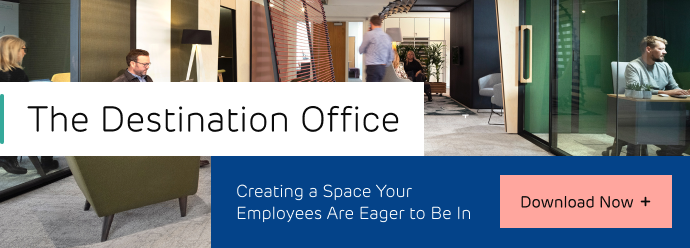For the first time in the history of the workplace, four generations are now side by side in the office together. Is it creating new tensions to negotiate or commercial opportunities for businesses to seize?
A workforce that reflects the world’s diversity
The Work Foundation’s latest research flags the profound demographic shifts of the last few decades:
“The modern workforce has a greater presence of women, a broader representation of different ethnic minority groups, more disabled people, and higher numbers of people who are working into their late 60s and 70s than ever before. In the US, two in five workers (41%) expect to work beyond the age of 65 – yet 30 years ago it was just 12%.”
The Work Foundation, WORKING TOGETHER: MAXIMISING THE OPPORTUNITIES OF A MULTIGENERATIONAL WORKFORCE
Who’s who in the multigenerational workplace?
Four generations with very different experiences and outlooks make up the active workforce today:

With a mix of age groups stretching from Baby Boomers to Gen Zers, turbocharged by immigration and marked by major differences in culture and technical literacy, there seems greater potential for conflict and misunderstanding in the workplace than ever before.
The good news
However, far from presenting a picture of conflict in the workplace - the Work Foundation report is optimistic about the future impact of a diverse, multigenerational workforce on culture, productivity and innovation:
“Multigenerational workplaces are here to stay – and they bring a raft of opportunities and challenges for employers. The presence of different generations in the workforce can enable knowledge sharing and skills transfer, and each age cohort can contribute unique ideas to the organisation, leading to a more dynamic and creative workplace.”
But there are challenges
The radically different experiences and expectations of each of these generations are real. Their competing demands present new challenges for employers who want to maximise returns from their diverse talents.
The report shows that in multigenerational companies there is a growing need to improve inter-team communication, training opportunities and working flexibility to maximise retention and business performance across the age spectrum.

Addressing the gaps: policies and practices
Significantly, the research underlines serious gaps in age-inclusive policies within organisations that are making it harder to build workforces that can work together.
Without practical policies that recognise and support their different needs, the multigenerational workforce is at risk of becoming disengaged and mutually suspicious.
In their research the Work Foundation found gaps in:
-
Inclusivity policy: Only 18% of leaders include age in their Equality, Diversity, and Inclusion (EDI) policies.
-
Training: Only 21% provide line management training specifically for multigenerational workplaces.
-
Menopause Support: Only 16% have policies to support employees transitioning through menopause.
Is your business ready to make the most of a newly diverse workforce?
To address and bridge all these gaps, the report recommends focusing on building working environments and practices that foreground learning, collaboration and personal empowerment across the age spectrum.
Lifelong learning
It seems the need for greater training opportunities for every generation within businesses is acute.
The %age of employers who have learning and development practices:

The report suggests fostering a culture of continuous learning and career development for all employees to plug these gaps.
Building active learning environments in your workplace can bring incredible benefits to every generation. From older age groups who need to develop their digital skills, to Millenials and Gen Zers who need to focus on building leadership potential - each age group can and must continue learning from each other.
Workplace design and furnishing choices can support this learning mindset:
-
Open collaborative areas can enable group work, discussions and training
-
Furniture should be mobile and modular to support different learning postures
-
Furniture can cocoon workers doing individual work in open spaces
.jpg?width=691&height=389&name=Lagunita_Focus_nook%20(1).jpg)
-
Project rooms for team-based activities
-
Cameras and screens for looping in remote colleagues and external trainers

-
Breakout spaces near meeting rooms for informal follow-up conversations
"For active learning to truly succeed, the built environment needs to step up and do more. Spaces need to be inclusive, supporting both in-room and remote participants equally, and they need to be flexible to accommodate different learning modes and activities."
Source: Steelcase's "Three Concepts for Creating Better Hybrid Learning Spaces".
For more insights into the kind of furniture and technology that can support an ‘always on’ learning culture, read our interview with IE Senior Designer Nuno Correia about the world of active learning.
Inclusive socialising
With more remote working and more diversity in workplaces, the ‘afterwork drink’ is rapidly becoming the least attractive socialising option for many.
But the need for employees to connect on a personal level has never been greater—as we see less of each other in person and cultural divides threaten cross-generational communication.
The Work Foundation report demonstrates how many employers lack the policies and facilities for multi-generational social events to happen in structured and enjoyable ways for everyone involved:
The %age of employers who have social and cultural policies and practices:

There are many exciting opportunities to use the workplace as social space. Businesses just need to be sensitive and imaginative in how they support the needs of generations to connect.
As one Gen Zer commented on iNews:
“This week’s workplace report suggest replacing after work boozing with breakfasts or lunchtime socials and activities like bowling instead. I work for myself, from home, now – where, excitingly, I drink water, sometimes coffee – but, back in the office, I’d have loved an option that didn’t put drinking front and centre.”
iNews, “Gen Z are phasing out after-work drinks, and I’m so glad”, Deborah Linton
Flexible working
Embracing flexible work arrangements to meet the diverse needs of a multigenerational workforce is essential. This entails building all the technology and facilities where hybrid working can happen.
For an older generation this can help balance work and family life - but for a younger generation, it can mean supporting a more radical form of digital nomadism.
But flexible working should also mean supporting the different physical needs of those in different life stages.
For example, the Work Foundation report particularly focuses on the effect menopause has on women's workplace experiences. It recommends several changes in workplace policy and practice to accommodate these needs and ensure women in this life stage are adequately supported. Read our blog for practical help in designing menopause-friendly workplaces that give women more freedom and control within their working environments.

Conclusions and recommendations
The Work Foundation report concludes that multigenerational workplaces offer significant opportunities for innovation, knowledge sharing, and improved organisational performance.
However, realising these benefits requires a shift away from stereotypes and a focus on creating inclusive, supportive environments. Employers are encouraged to adopt the recommended principles to maximize the potential of their diverse workforces.
-
Support line managers: equip them with the necessary skills to manage diverse teams.
-
Implement age-inclusive policies: ensure recruitment, retention, job and workplace design are inclusive.
-
Foster inclusive cultures: develop policies that encourage social inclusion and responsible behaviour.
By embracing these recommendations, organisations can create workplaces that not only accommodate but also celebrate the diversity of their employees, leading to a more dynamic, productive, and engaged workforce.









